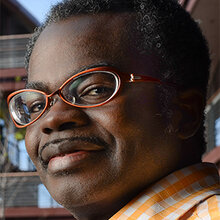
Kwabena Boahen
Kwabena Boahen is a Professor of Bioengineering, Electrical Engineering, and by courtesy Computer Science at Stanford University; an investigator in Stanford’s Bio-X Institute, System X Alliance, and Wu Tsai Neurosciences Institute; and the founding director of Stanford’s Brains in Silicon Lab. His group models the nervous system computationally to elucidate principles of neural design at the cellular, circuit, and systems levels; and synthesizes neuromorphic electronic systems that scale energy-use with size as efficiently as the brain does. His interest in neural networks developed soon after he left his native Ghana to pursue undergraduate studies in Electrical and Computer Engineering at Johns Hopkins University, Baltimore, in 1985. He went on to earn a doctorate in Computation and Neural Systems at the California Institute of Technology in 1997. From 1997 to 2005 he was on the faculty of University of Pennsylvania, Philadelphia PA, where he was the inaugural holder of the Skirkanich Term Junior Chair. His research has resulted in over a hundred publications, including a cover story in Scientific American featuring his lab’s work on a silicon retina and a silicon tectum that “wire together” automatically (May 2005). He has been invited to give over a hundred seminar, plenary, and keynote talks, including a 2007 TED talk, “A computer that works like the brain”, with over seven hundred thousand views. He has received several distinguished honors, including a Packard Fellowship for Science and Engineering (1999) and a National Institutes of Health Director’s Pioneer Award (2006). He was elected a fellow of the American Institute for Medical and Biological Engineering (2016) and of the Institute of Electrical and Electronic Engineers (2016) in recognition of his lab’s work on Neurogrid, an iPad-size platform that emulates the cerebral cortex in biophysical detail and at functional scale, a combination that hitherto required a supercomputer. He has led several multi-university, multi-investigator research efforts, including one that raised the level of abstraction at which neuromorphic chips are ‘programmed’ by co-designing hardware and software (Brainstorm Project). A spin-out from his Stanford lab, Femtosense Inc (2018), is commercializing this breakthrough. He teaches graduate courses in computational neuroscience and neuromorphic computing, has trained over twenty graduate students, and mentored four postdoctoral researchers, including the designer of NeuraLink’s first implantable chip.
